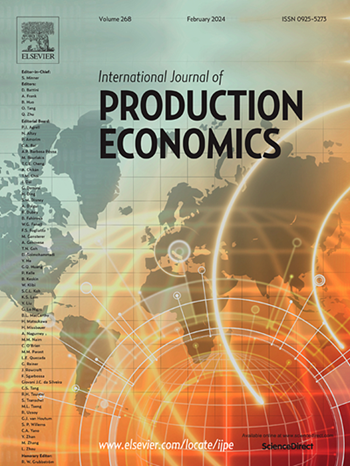Production–inventory planning in high-tech low-volume manufacturing supply chains
IF 10
1区 工程技术
Q1 ENGINEERING, INDUSTRIAL
引用次数: 0
Abstract
This paper studies production–inventory planning in high-tech low-volume manufacturing supply chains, where long production lead times, complex network structures, multiple capacity constraints, as well as non-stationary demand and supply uncertainty, complicate production and safety stock placement decisions. The majority of academic approaches considers these problems under limiting assumptions about the system, while practitioners mostly rely on suboptimal heuristic integration of plans. We bridge the gap between stylized stochastic inventory models and industrial production planning practices by developing novel practice-driven multi-stage stochastic programming models. We validate our methodology in the uncapacitated single-product setting without lead time uncertainty by benchmarking strategic safety stock levels against an approach based on the seminal stochastic service model, which we tailor to accommodate the non-stationary demand. Additionally, we analyze the impact of capacity constraints and lead time uncertainty on safety stock requirements, and demonstrate how the performance of the benchmark solution regresses under these complexities. Finally, to support production–inventory decisions in view of the short life cycles of high-tech products, we adapt our modeling framework to new product introduction planning under modular product design, motivated by the setting of our industry partner, ASML. Following a fast-time-to-market strategy, we investigate optimal ramp-up and phase-out plans given interdependent demand and supply uncertainty due to risks in technology development. This study highlights the flexibility of our approach in addressing specific challenges encountered in real-world planning problems.
高科技小批量制造供应链中的生产库存计划
本文研究了高技术小批量制造供应链中的生产-库存规划问题,该供应链的生产周期长,网络结构复杂,产能约束多,需求和供应不确定性非平稳,使得生产和安全库存配置决策复杂化。大多数学术方法在对系统的有限假设下考虑这些问题,而实践者大多依赖于次优的启发式计划整合。我们通过开发新的实践驱动的多阶段随机规划模型,弥合了程式化随机库存模型与工业生产计划实践之间的差距。我们通过对基于开创性随机服务模型的战略安全库存水平进行基准测试,验证了我们的方法在无生产能力的单一产品环境下的有效性,该模型可以适应非平稳需求。此外,我们分析了产能约束和交货期不确定性对安全库存需求的影响,并演示了在这些复杂性下基准解决方案的性能如何退化。最后,考虑到高科技产品生命周期短,为了支持生产库存决策,我们将建模框架调整为模块化产品设计下的新产品引入计划,并受到我们的行业合作伙伴ASML的启发。根据快速上市策略,我们研究了基于技术开发风险的相互依赖的需求和供应不确定性的最佳增加和淘汰计划。这项研究突出了我们在解决实际规划问题中遇到的具体挑战时所采用的方法的灵活性。
本文章由计算机程序翻译,如有差异,请以英文原文为准。
求助全文
约1分钟内获得全文
求助全文
来源期刊
CiteScore
21.40
自引率
7.50%
发文量
266
审稿时长
52 days
期刊介绍:
The International Journal of Production Economics focuses on the interface between engineering and management. It covers all aspects of manufacturing and process industries, as well as production in general. The journal is interdisciplinary, considering activities throughout the product life cycle and material flow cycle. It aims to disseminate knowledge for improving industrial practice and strengthening the theoretical base for decision making. The journal serves as a forum for exchanging ideas and presenting new developments in theory and application, combining academic standards with practical value for industrial applications.

 求助内容:
求助内容: 应助结果提醒方式:
应助结果提醒方式:


